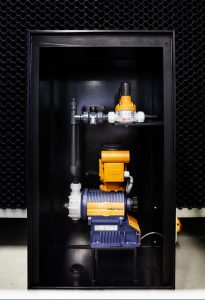REQUEST ADVICE CONVERSATION
We are happy to advise you how to solve odour and emission problems. We strive to find the best sustainable solution. As every question is different, we would like to have personal contact with you, so we can go through all the details carefully.
Enter your details and one of our odour experts will contact you to make an appointment:
venturi scrubbers
A venturi scrubber uses the kinetic energy of an air stream to achieve dust removal through collisions. The airflow contaminated with dust is accelerated by a narrowing section, whereby the air speed increases to 45 to 120 meters per second.
We often use venturi scrubbers because of their dual function: removing solids and cooling the waste gases.


the system
Water is injected for the acceleration and sprayed by the high air velocity. Dust particles collide with and are encapsulated by millions of small water droplets. A sharp transition between the dry and wet zone has been made to prevent dust accumulation on the entry side of the venturi.
A venturi scrubber consists of three sections: a converging section, a throat section, and a diverging section. The inlet gas stream enters the converging section and, as the area decreases, gas velocity increases. Liquid is introduced either at the throat or at the entrance to the converging section.
The inlet gas, forced to move at extremely high velocities in the small throat section, shears the liquid from its walls, producing an enormous number of very tiny droplets.
Particle and gas removal occur in the diverging section as the inlet gas stream mixes with the fog of tiny liquid droplets. The inlet stream then exits through the diverging section, where it is forced to slow down.
Venturis can be used to collect both particulate and gaseous pollutants, but they are more effective in removing particles than gaseous pollutants.

Advantages of the AEC venturi scrubber:
- Uncomplicated technology
- Compact system
- Easy to operate
- Applicable in many sectors
- Easy to install
- Low maintenance
- Reliable technique



